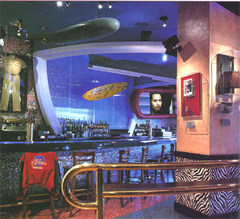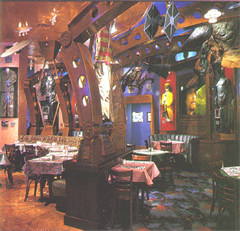Planet Hollywood Beverly Hills
By Rebecca Day
October 1996
Star sightings abound, video images dance and music rocks in this chic world of multimedia delights
Beverly Hills hasn't witnessed an event like the September 1995 opening of Planet Hollywood since, well, maybe ever. Equating the event with Oscar-night potential for star sightings, thousands of curious onlookers lined the two-block red carpet down the fabled Rodeo Drive as invited guests wheeled up for the private debut. There, the throngs toed up for a glimpse of the 100-plus celebs who turned out to christen the Beverly Hills version of the entertainment industry's glitzy high-tech gallery. Inside, a year later, the show is still going on.
|
|
|
Walls packed with movie memorabilia vie for space with 13 video screens and 134 speakers from JBL and Speakercraft installed by TR Technologies. |
|
|
|
Photographs by David Glomb |
When you shimmy inside Planet Hollywood, you're either there to see someone or to be seen. Maybe you're Geena Davis or Sly Stallone verifying the likeness of your handprints cast into plaster tiles on the wall. Maybe you're a hopeful, eyeing a spot where your own paw prints will land when you've made it. Maybe you're a fan, pressing your hands against the palms of your fave's-- the next best thing to their being there. But no matter who you are, you can't help being wowed by the multimedia spectacle before you.
On the main floor, you've arrived at a very different place. Amid the faux leopard-skin seats, Hollywood memorabilia and chic neon lighting, you have the impression that this isn't just any club, and your expectations soar. You want to hear loud music. You really want to hear it undistorted and pure. You want videos you can see--not some washed-out images on a small screen. You want to live, breathe and eat Hollywood, and you're there to have a good time. The joint doesn't disappoint.
That's the Planet Hollywood that rocks. How about the one that rumbles? You don't have to be in the business to rent out the screening room for a private viewing. Walk inside. Close the door. The three-figure decibel level of the Planet has gone into mute and you're standing inside a silent space. In fact, you're standing in a space within a space within the Planet in a kind of cosmic den. It's a combination executive office and living room. Oversized plush chairs await. Sit down. Pick up the phone and ring the projectionist. Choose from the library of film and video titles or, if you're Stallone, Demi or Quentin, you bring your own. Kick back with your favorite beverage and enjoy the show.
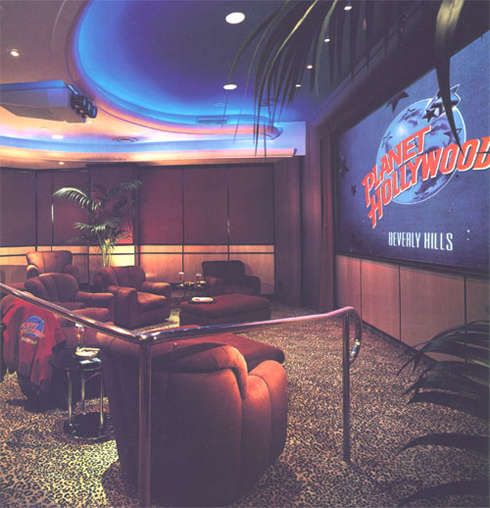 |
|
An upstairs hallway leads to an oasis in Planet Hollywood- a 30 x 35 foot private screening room that is isolated from the hustle, bustle and noise of the restaurant. A Barco projector enhanced with a Faroudja line quadrupler fires onto a Stewart Microperf filmscreen for film-like picture quality. |
To get the full screening room experience, you need complete isolation. No loud rock music or crowd noise from below. The solution was to simply decouple the room from its adjacent walls to create a floating theater. A multiple-layer drywall ceiling protects the upstairs investment company from the action in the theater, and the plywood floor rests on sheets of Fiberglas buffered with a grid of rubber tiles. The screening room has its own air conditioning system so that ducts could be decoupled and routed as necessary without picking up sounds from the adjacent spaces.
Although the Planet screening room is a commercial installation designed for Hollywood bigs accustomed to commercial-spec sound, it uses a Home THX system to provide the sound for the cozy 30 x 35 foot space.
The solution for this private screening room is quality instead of quantity, and with seven bridged pairs of THX 450-watt Marantz MA500 amplifiers, no one's leaving this room wanting for volume.
The front-channel Snell THX LCR 2800 loudspeakers are mounted behind the Stewart Snapper Microperf screen supplemented by a pair of foot-and-a-half Snell subwoofers. This being the part of the world where rear-channel effects are created, there are two pairs of Snell THX dipole speakers in the rear and side walls behind removable acoustically transparent panels. To smooth out the thunderous explosions of the owners' next action picture, bass traps were installed in the rear corners of the theater's rectangular shell. Concealing them are curved acoustically transparent walls.
High-quality video images are driven by a Barco Graphics 1209 projector perfected by a Faroudja VP400 line quadrupler. Those who have film will always prefer that medium, but the Faroudja-enhanced Barco delivers a picture that rivals film. Video source equipment runs the gamut: a 3/4-inch Sony 7020 pro video tape deck, a Pioneer laserdisc player, a Sony EX1400 Betacam deck, a Panasonic PVS4580 Super-VHS VCR and a Sony SAT BS1 Digital Satellite System.
Stepping up to the pro world, a pair of Simplex 35mm projectors were selected. There are two so that one can always be cued up and ready to go while the other one's rolling. Single-track mag heads were added to each projector, which filmmakers can use when reviewing dailies after a day of shoots. It's also set up for just about any surround-sound system likely to be faced. The Dolby CP65 audio rack does it all: surround-sound processing, switching, equalization, noise reduction and level control. The room is also equipped for DTS and Sony's SDDS six-channel digital soundtracks. Illuminating the theater's interior is a Lutron GRAFIK Eye system used in home theaters across the country, but with Lutron power boosters added for the extensive lighting and a special Lutron interface that adds the unique capability to dim the ceiling neon lights.
That's the private world of Planet Hollywood. In the public sphere, customers may not actually know it but they're being entertained by a carefully orchestrated multimedia system. The computer-controlled A/V and lighting system was designed and installed by Ted Rothstein, who has spent long years in the recording business, and designed recording studios for such artists as Jimi Hendrix, Stevie Wonder and Pink Floyd, over 60 Planet Hollywood A/V systems, 18 Hard Rocks and dozens of other clubs. His TR Technologies TRDJ Automation System is the electronic backbone of Planet Hollywood. It controls room lights, crossfading between tracks for smooth transitions between songs, programmed information for TR's 300-disc changer, the Pioneer 50-disc laserdisc changer, the 13 direct-view, rear-projection and front-projection video screens.
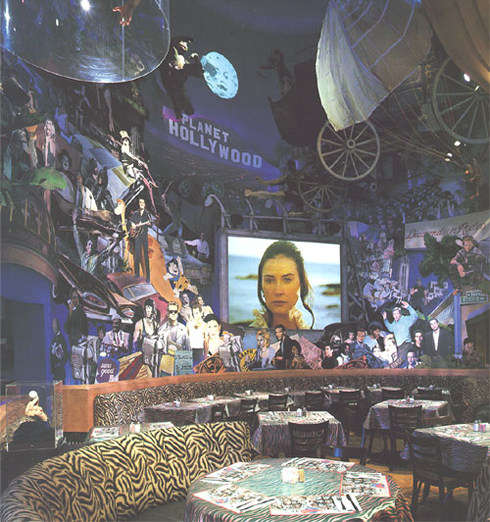 |
Rothstein also determines what goes through all 134 speakers and to all of the screens. "Every time an audio track comes up, we show a still image on all of the screens combining the name and a picture of the movie so when you hear the music you can look at the screen and remember what movie it was from," Rothstein says. He has developed a database that controls play of all music and videos. The time, sophistication and upkeep required to keep the system fresh, compelling and up to Rothstein's standards require the full-time efforts of several computer programmers who constantly update the disc libraries and write the necessary code for them to work within the system.
The system can play from user created play lists, but its real power is "autoplay" by parameter. Users adjust parameters "on the fly" according to not only genre and artist, but esoterica including beats-per-minute, chart position, preference ratings and a host of other filters. Songs are carefully selected according to position within a sequence and the beats are matched and synchronized for smooth transitions. There's even a dance filter that will only let through tracks appropriate for dancing.
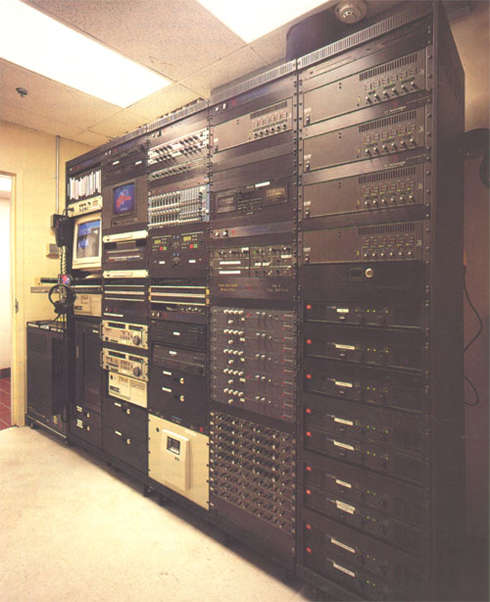 |
|
A monster of an equipment rack is home to a multitude of components from Rane, JBL, Pioneer, Denon, Panasonic, and Carver. A Pioneer 50-disc laserdisc player provides continuous entertainment to the 70-, 50-, and 35-inch video screens throughout the Planet. |
With 25 years' experience as a designer of recording studios and studio monitor loud-speakers, Rothstein knows good sound, and he won't settle for anything less. "I used my own studio experience with equipment and technology to get the source to the speakers and maintain quality," he says of the Planet Hollywood system. "And then I went back and I improved the source with this computer system."
The final step to good sound, he says, is getting the music from the speakers to the listeners with the same quality goal in mind. His strategy is based partially on near-field monitoring. "When you have an acoustic space such as this one, which cannot be corrected, the best thing is to bring the sound close to the listeners' ears--getting the listener into the near-field of the sound rather than the reverberant field."
That's where the 134 speakers come in. "As you take the speaker further away, the ratio of direct to reverherant sound is getting worse," Rothstein says, "and the clarity, intelligibility and quality of the sound suffers."
Maybe in some other club, but that's not how it goes on the Planet Hollywood.
